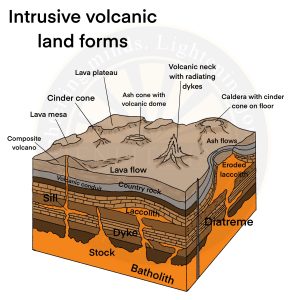Intrusive Forms
- The lava that is discharged during volcanic eruptions on cooling develops into igneous rocks.
- The cooling may take place either on arriving at the surface or also while the lava is still in the crustal portion.
- According to the location of the cooling of the lava, igneous rocks are categorised as plutonic rocks and volcanic rocks.
- The lava that cools inside the crustal portions takes diverse forms.
- These forms are called intrusive forms.
- Batholiths
- It is a large body of magmatic material that cools in the deeper depth of the crust moulds, in the form of large domes.
- They appear on the surface only after the denudation processes eliminate the overlying materials.
- These are granitic bodies
- Laccoliths
- These are large dome-shaped intrusive bodies with a level base and linked by a pipe-like channel from below.
- It bears a similarity to the surface volcanic domes of the composite volcano, only these are located at deeper depths.
- It can be considered as the localised source of lava.
- Lopolith
- A lopolith is a large igneous intrusion which is lenticular in shape with a depressed central region.
- Lopoliths are generally concordant with the intruded strata with dike or funnel-shaped feeder bodies below the body.
- Phacolith
- It is a wavy mass of intrusive rocks found at the base of synclines.
- Sills
- The near horizontal bodies of the intrusive igneous rocks are called sill.
- Dykes
- Dykes are the most commonly found intrusive forms in the western Maharashtra area.
- When the lava makes its channel through cracks and the fissures, it solidifies almost perpendicular to the ground.
- This gets cooled in the same position to grow a wall-like structure. Such structures are known as dykes.
- Batholiths

